Women's Empowerment as a Key Strategy to End Global Hunger
VerifiedAdded on 2022/10/04
|10
|2958
|15
Essay
AI Summary
This essay investigates the critical link between women's empowerment and the global challenge of hunger. It highlights the disproportionate impact of food insecurity on women due to gender discrimination, exploring issues such as unequal access to education, resources, and decision-making power. The essay examines the impact of global crises like food price volatility and ecological challenges on women's vulnerability. It emphasizes the importance of gender equality in achieving food security, citing the potential for increased agricultural productivity and reduced hunger rates when women are empowered. Furthermore, the essay discusses the role of international organizations and government initiatives in promoting women's rights and economic opportunities. The essay concludes by advocating for a multi-faceted approach that addresses gender inequalities, promotes education, and fosters collective action to create a more equitable and food-secure world.
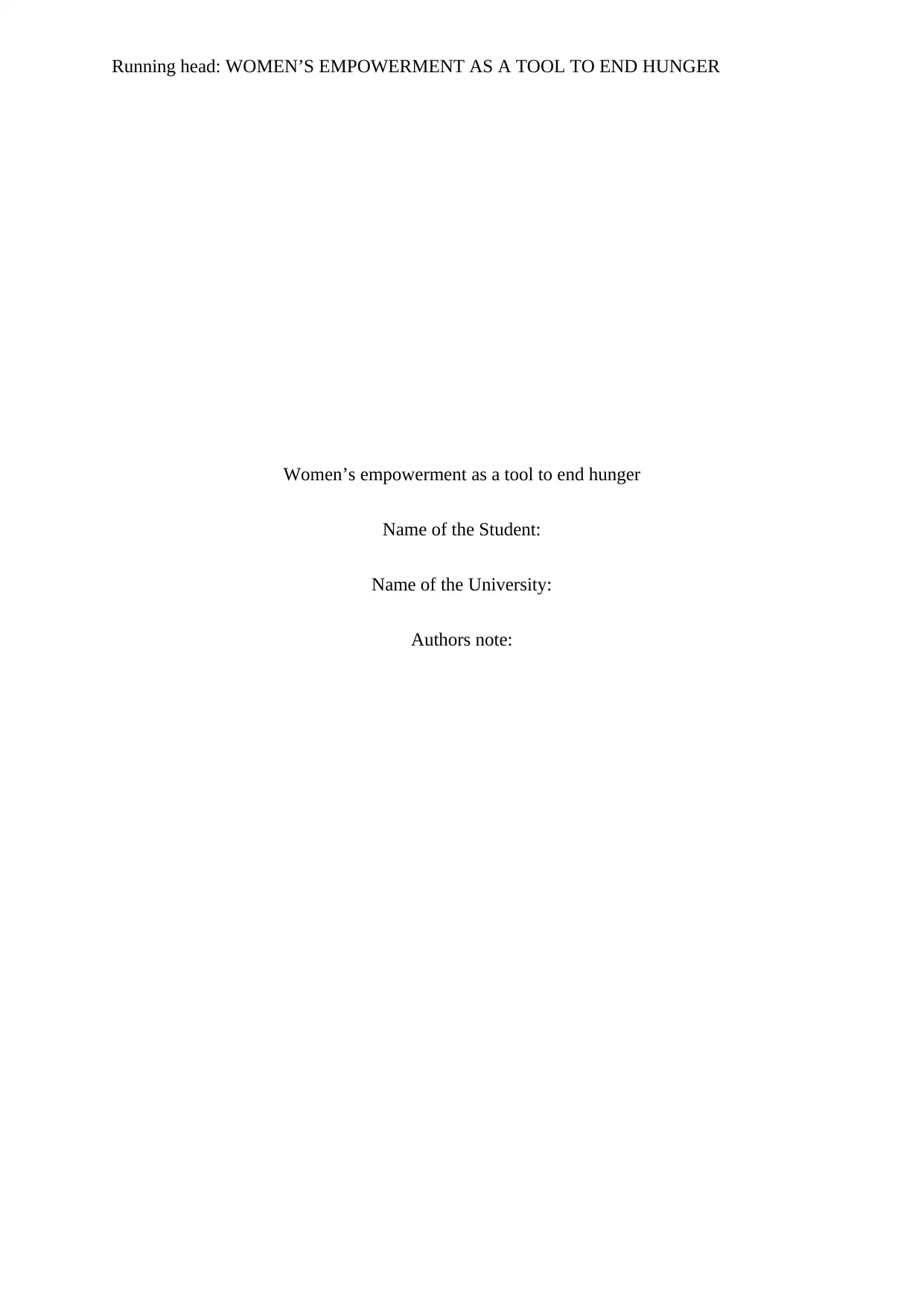
Running head: WOMEN’S EMPOWERMENT AS A TOOL TO END HUNGER
Women’s empowerment as a tool to end hunger
Name of the Student:
Name of the University:
Authors note:
Women’s empowerment as a tool to end hunger
Name of the Student:
Name of the University:
Authors note:
Paraphrase This Document
Need a fresh take? Get an instant paraphrase of this document with our AI Paraphraser
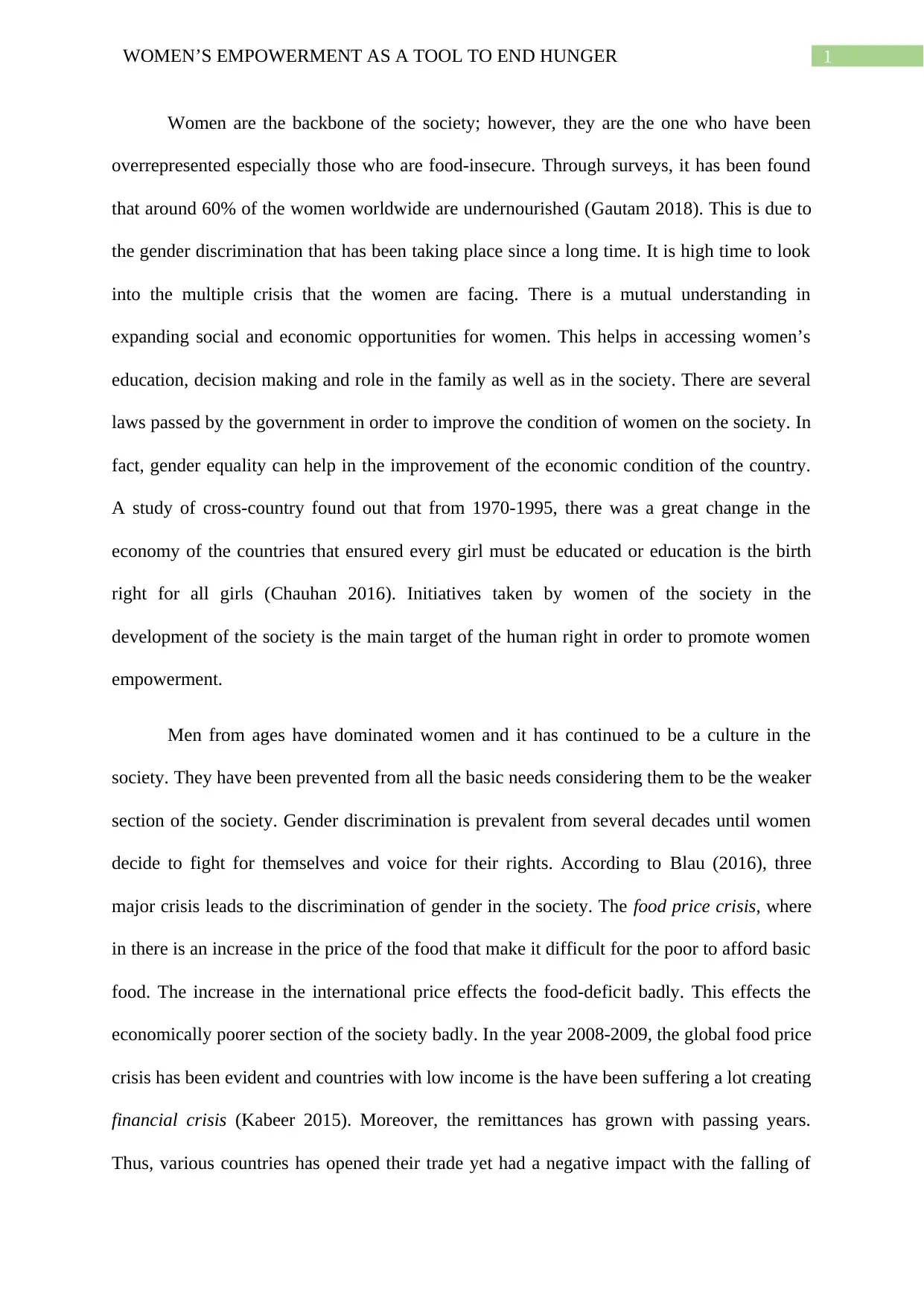
1WOMEN’S EMPOWERMENT AS A TOOL TO END HUNGER
Women are the backbone of the society; however, they are the one who have been
overrepresented especially those who are food-insecure. Through surveys, it has been found
that around 60% of the women worldwide are undernourished (Gautam 2018). This is due to
the gender discrimination that has been taking place since a long time. It is high time to look
into the multiple crisis that the women are facing. There is a mutual understanding in
expanding social and economic opportunities for women. This helps in accessing women’s
education, decision making and role in the family as well as in the society. There are several
laws passed by the government in order to improve the condition of women on the society. In
fact, gender equality can help in the improvement of the economic condition of the country.
A study of cross-country found out that from 1970-1995, there was a great change in the
economy of the countries that ensured every girl must be educated or education is the birth
right for all girls (Chauhan 2016). Initiatives taken by women of the society in the
development of the society is the main target of the human right in order to promote women
empowerment.
Men from ages have dominated women and it has continued to be a culture in the
society. They have been prevented from all the basic needs considering them to be the weaker
section of the society. Gender discrimination is prevalent from several decades until women
decide to fight for themselves and voice for their rights. According to Blau (2016), three
major crisis leads to the discrimination of gender in the society. The food price crisis, where
in there is an increase in the price of the food that make it difficult for the poor to afford basic
food. The increase in the international price effects the food-deficit badly. This effects the
economically poorer section of the society badly. In the year 2008-2009, the global food price
crisis has been evident and countries with low income is the have been suffering a lot creating
financial crisis (Kabeer 2015). Moreover, the remittances has grown with passing years.
Thus, various countries has opened their trade yet had a negative impact with the falling of
Women are the backbone of the society; however, they are the one who have been
overrepresented especially those who are food-insecure. Through surveys, it has been found
that around 60% of the women worldwide are undernourished (Gautam 2018). This is due to
the gender discrimination that has been taking place since a long time. It is high time to look
into the multiple crisis that the women are facing. There is a mutual understanding in
expanding social and economic opportunities for women. This helps in accessing women’s
education, decision making and role in the family as well as in the society. There are several
laws passed by the government in order to improve the condition of women on the society. In
fact, gender equality can help in the improvement of the economic condition of the country.
A study of cross-country found out that from 1970-1995, there was a great change in the
economy of the countries that ensured every girl must be educated or education is the birth
right for all girls (Chauhan 2016). Initiatives taken by women of the society in the
development of the society is the main target of the human right in order to promote women
empowerment.
Men from ages have dominated women and it has continued to be a culture in the
society. They have been prevented from all the basic needs considering them to be the weaker
section of the society. Gender discrimination is prevalent from several decades until women
decide to fight for themselves and voice for their rights. According to Blau (2016), three
major crisis leads to the discrimination of gender in the society. The food price crisis, where
in there is an increase in the price of the food that make it difficult for the poor to afford basic
food. The increase in the international price effects the food-deficit badly. This effects the
economically poorer section of the society badly. In the year 2008-2009, the global food price
crisis has been evident and countries with low income is the have been suffering a lot creating
financial crisis (Kabeer 2015). Moreover, the remittances has grown with passing years.
Thus, various countries has opened their trade yet had a negative impact with the falling of
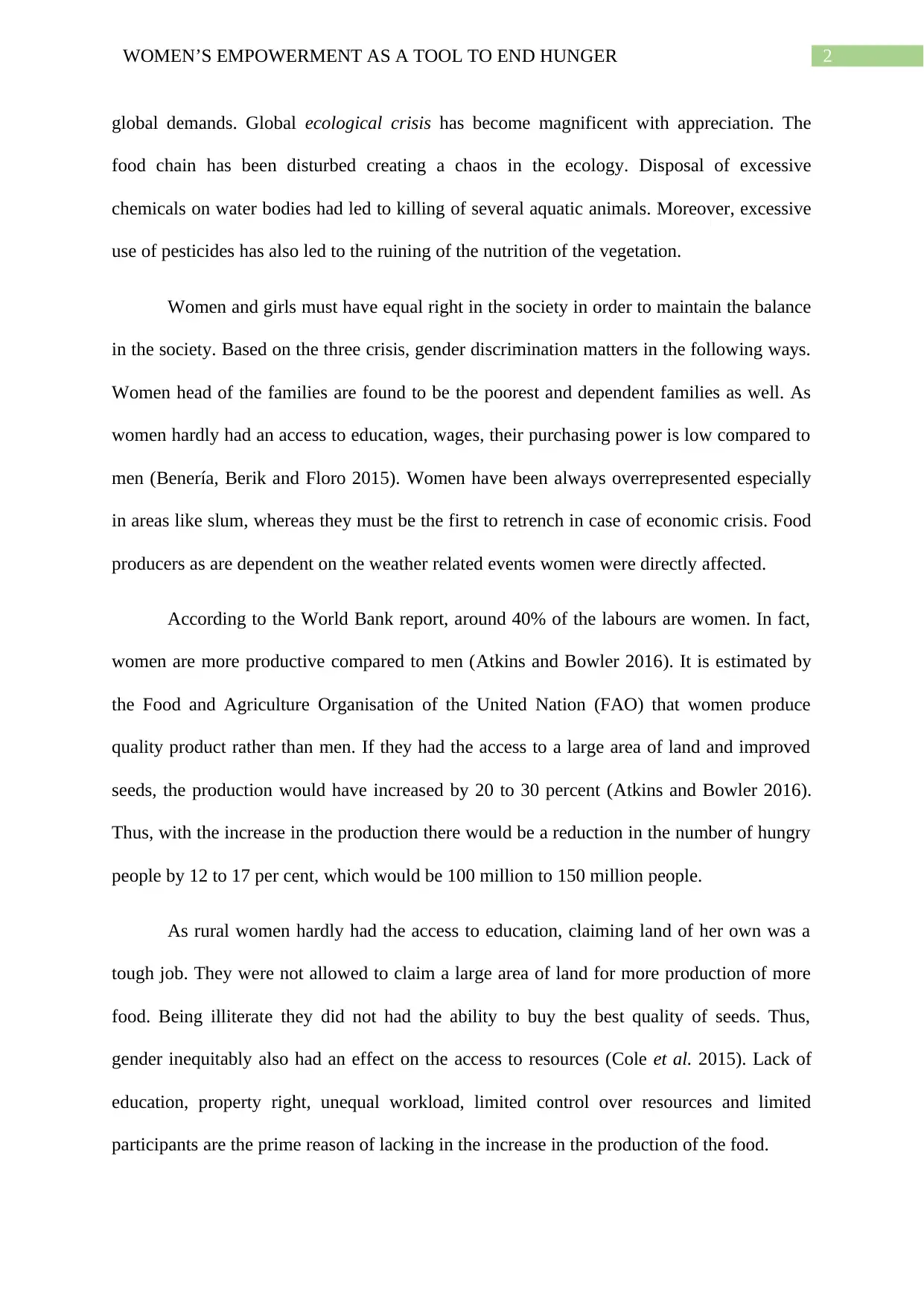
2WOMEN’S EMPOWERMENT AS A TOOL TO END HUNGER
global demands. Global ecological crisis has become magnificent with appreciation. The
food chain has been disturbed creating a chaos in the ecology. Disposal of excessive
chemicals on water bodies had led to killing of several aquatic animals. Moreover, excessive
use of pesticides has also led to the ruining of the nutrition of the vegetation.
Women and girls must have equal right in the society in order to maintain the balance
in the society. Based on the three crisis, gender discrimination matters in the following ways.
Women head of the families are found to be the poorest and dependent families as well. As
women hardly had an access to education, wages, their purchasing power is low compared to
men (Benería, Berik and Floro 2015). Women have been always overrepresented especially
in areas like slum, whereas they must be the first to retrench in case of economic crisis. Food
producers as are dependent on the weather related events women were directly affected.
According to the World Bank report, around 40% of the labours are women. In fact,
women are more productive compared to men (Atkins and Bowler 2016). It is estimated by
the Food and Agriculture Organisation of the United Nation (FAO) that women produce
quality product rather than men. If they had the access to a large area of land and improved
seeds, the production would have increased by 20 to 30 percent (Atkins and Bowler 2016).
Thus, with the increase in the production there would be a reduction in the number of hungry
people by 12 to 17 per cent, which would be 100 million to 150 million people.
As rural women hardly had the access to education, claiming land of her own was a
tough job. They were not allowed to claim a large area of land for more production of more
food. Being illiterate they did not had the ability to buy the best quality of seeds. Thus,
gender inequitably also had an effect on the access to resources (Cole et al. 2015). Lack of
education, property right, unequal workload, limited control over resources and limited
participants are the prime reason of lacking in the increase in the production of the food.
global demands. Global ecological crisis has become magnificent with appreciation. The
food chain has been disturbed creating a chaos in the ecology. Disposal of excessive
chemicals on water bodies had led to killing of several aquatic animals. Moreover, excessive
use of pesticides has also led to the ruining of the nutrition of the vegetation.
Women and girls must have equal right in the society in order to maintain the balance
in the society. Based on the three crisis, gender discrimination matters in the following ways.
Women head of the families are found to be the poorest and dependent families as well. As
women hardly had an access to education, wages, their purchasing power is low compared to
men (Benería, Berik and Floro 2015). Women have been always overrepresented especially
in areas like slum, whereas they must be the first to retrench in case of economic crisis. Food
producers as are dependent on the weather related events women were directly affected.
According to the World Bank report, around 40% of the labours are women. In fact,
women are more productive compared to men (Atkins and Bowler 2016). It is estimated by
the Food and Agriculture Organisation of the United Nation (FAO) that women produce
quality product rather than men. If they had the access to a large area of land and improved
seeds, the production would have increased by 20 to 30 percent (Atkins and Bowler 2016).
Thus, with the increase in the production there would be a reduction in the number of hungry
people by 12 to 17 per cent, which would be 100 million to 150 million people.
As rural women hardly had the access to education, claiming land of her own was a
tough job. They were not allowed to claim a large area of land for more production of more
food. Being illiterate they did not had the ability to buy the best quality of seeds. Thus,
gender inequitably also had an effect on the access to resources (Cole et al. 2015). Lack of
education, property right, unequal workload, limited control over resources and limited
participants are the prime reason of lacking in the increase in the production of the food.
⊘ This is a preview!⊘
Do you want full access?
Subscribe today to unlock all pages.

Trusted by 1+ million students worldwide
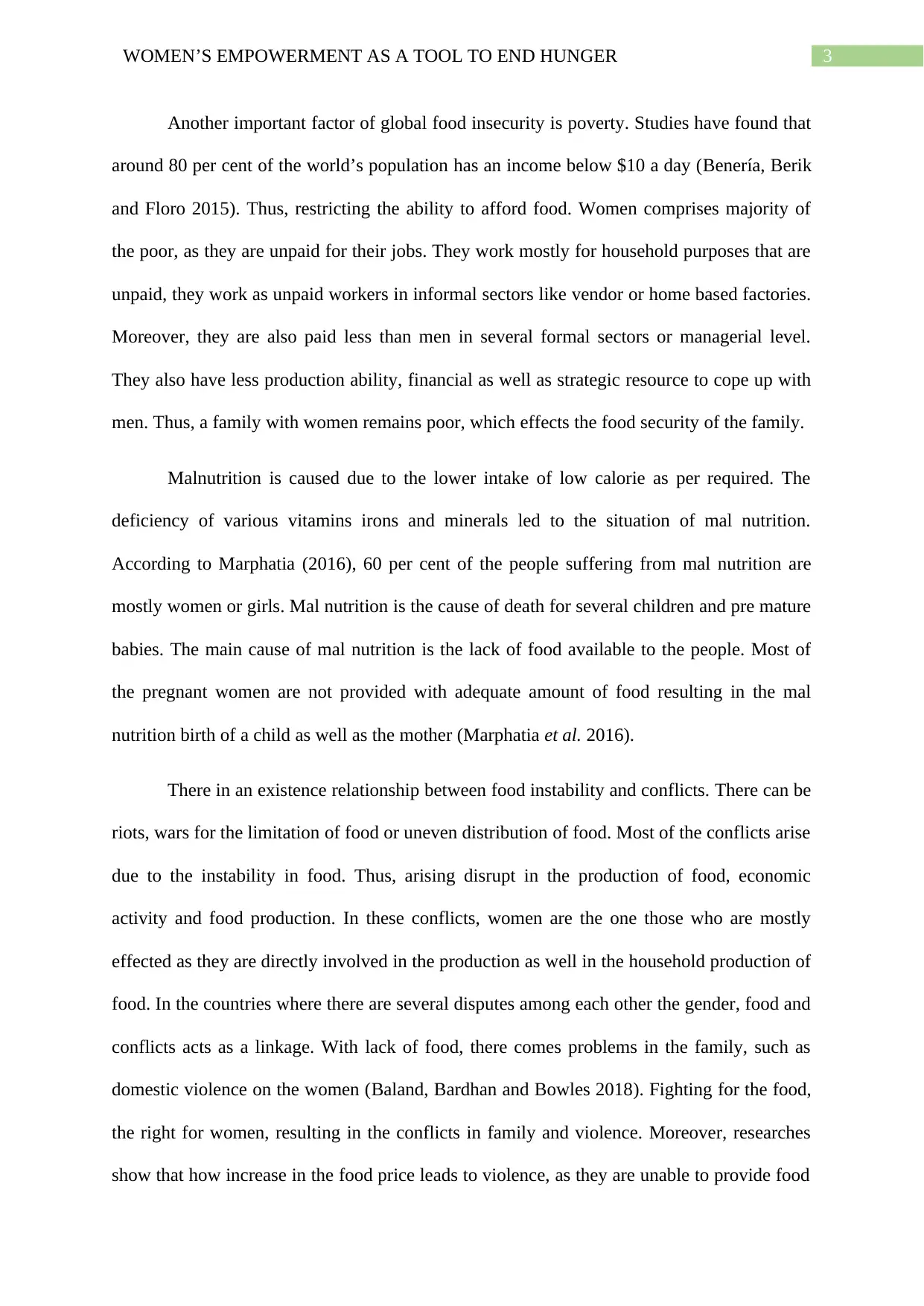
3WOMEN’S EMPOWERMENT AS A TOOL TO END HUNGER
Another important factor of global food insecurity is poverty. Studies have found that
around 80 per cent of the world’s population has an income below $10 a day (Benería, Berik
and Floro 2015). Thus, restricting the ability to afford food. Women comprises majority of
the poor, as they are unpaid for their jobs. They work mostly for household purposes that are
unpaid, they work as unpaid workers in informal sectors like vendor or home based factories.
Moreover, they are also paid less than men in several formal sectors or managerial level.
They also have less production ability, financial as well as strategic resource to cope up with
men. Thus, a family with women remains poor, which effects the food security of the family.
Malnutrition is caused due to the lower intake of low calorie as per required. The
deficiency of various vitamins irons and minerals led to the situation of mal nutrition.
According to Marphatia (2016), 60 per cent of the people suffering from mal nutrition are
mostly women or girls. Mal nutrition is the cause of death for several children and pre mature
babies. The main cause of mal nutrition is the lack of food available to the people. Most of
the pregnant women are not provided with adequate amount of food resulting in the mal
nutrition birth of a child as well as the mother (Marphatia et al. 2016).
There in an existence relationship between food instability and conflicts. There can be
riots, wars for the limitation of food or uneven distribution of food. Most of the conflicts arise
due to the instability in food. Thus, arising disrupt in the production of food, economic
activity and food production. In these conflicts, women are the one those who are mostly
effected as they are directly involved in the production as well in the household production of
food. In the countries where there are several disputes among each other the gender, food and
conflicts acts as a linkage. With lack of food, there comes problems in the family, such as
domestic violence on the women (Baland, Bardhan and Bowles 2018). Fighting for the food,
the right for women, resulting in the conflicts in family and violence. Moreover, researches
show that how increase in the food price leads to violence, as they are unable to provide food
Another important factor of global food insecurity is poverty. Studies have found that
around 80 per cent of the world’s population has an income below $10 a day (Benería, Berik
and Floro 2015). Thus, restricting the ability to afford food. Women comprises majority of
the poor, as they are unpaid for their jobs. They work mostly for household purposes that are
unpaid, they work as unpaid workers in informal sectors like vendor or home based factories.
Moreover, they are also paid less than men in several formal sectors or managerial level.
They also have less production ability, financial as well as strategic resource to cope up with
men. Thus, a family with women remains poor, which effects the food security of the family.
Malnutrition is caused due to the lower intake of low calorie as per required. The
deficiency of various vitamins irons and minerals led to the situation of mal nutrition.
According to Marphatia (2016), 60 per cent of the people suffering from mal nutrition are
mostly women or girls. Mal nutrition is the cause of death for several children and pre mature
babies. The main cause of mal nutrition is the lack of food available to the people. Most of
the pregnant women are not provided with adequate amount of food resulting in the mal
nutrition birth of a child as well as the mother (Marphatia et al. 2016).
There in an existence relationship between food instability and conflicts. There can be
riots, wars for the limitation of food or uneven distribution of food. Most of the conflicts arise
due to the instability in food. Thus, arising disrupt in the production of food, economic
activity and food production. In these conflicts, women are the one those who are mostly
effected as they are directly involved in the production as well in the household production of
food. In the countries where there are several disputes among each other the gender, food and
conflicts acts as a linkage. With lack of food, there comes problems in the family, such as
domestic violence on the women (Baland, Bardhan and Bowles 2018). Fighting for the food,
the right for women, resulting in the conflicts in family and violence. Moreover, researches
show that how increase in the food price leads to violence, as they are unable to provide food
Paraphrase This Document
Need a fresh take? Get an instant paraphrase of this document with our AI Paraphraser
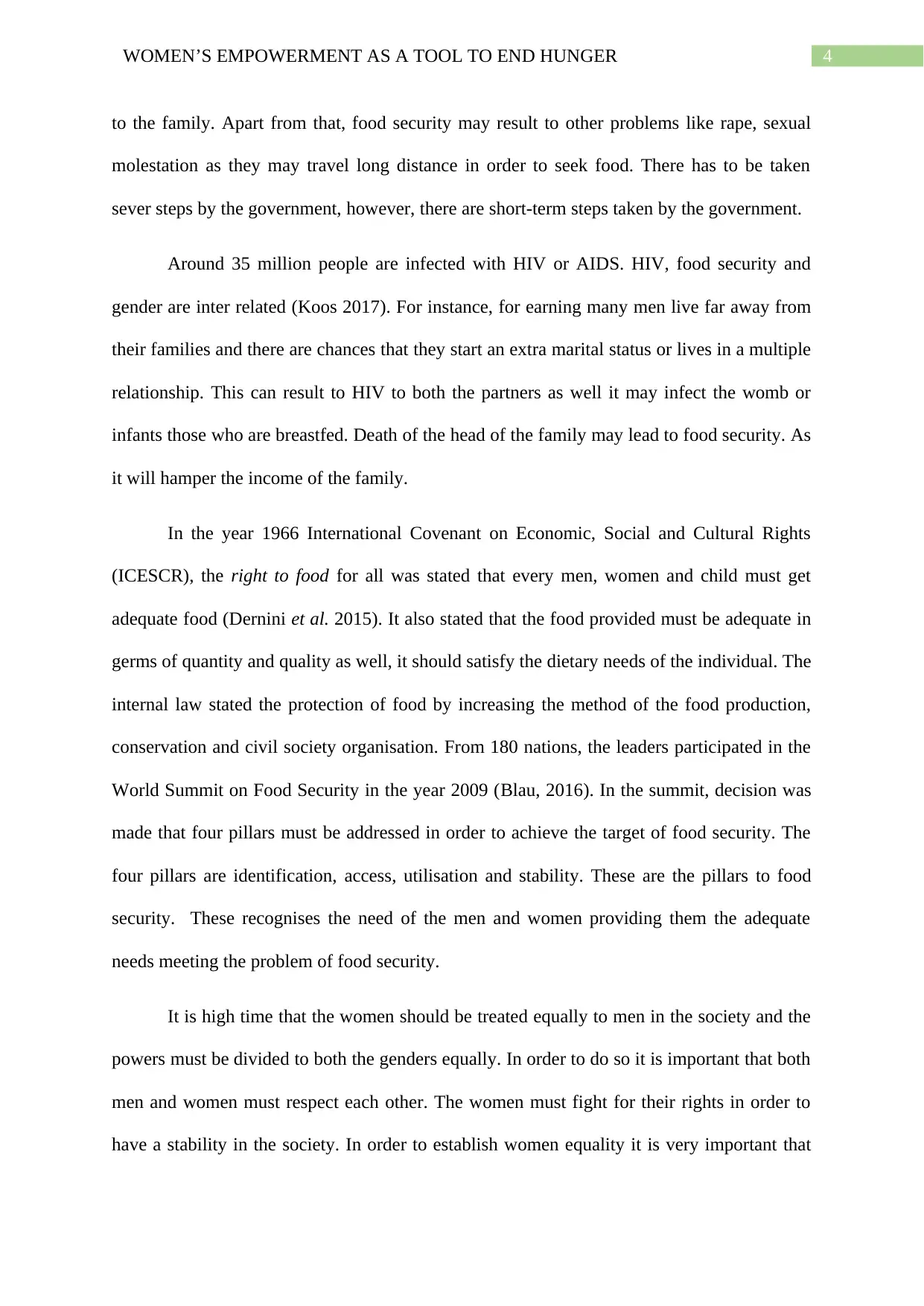
4WOMEN’S EMPOWERMENT AS A TOOL TO END HUNGER
to the family. Apart from that, food security may result to other problems like rape, sexual
molestation as they may travel long distance in order to seek food. There has to be taken
sever steps by the government, however, there are short-term steps taken by the government.
Around 35 million people are infected with HIV or AIDS. HIV, food security and
gender are inter related (Koos 2017). For instance, for earning many men live far away from
their families and there are chances that they start an extra marital status or lives in a multiple
relationship. This can result to HIV to both the partners as well it may infect the womb or
infants those who are breastfed. Death of the head of the family may lead to food security. As
it will hamper the income of the family.
In the year 1966 International Covenant on Economic, Social and Cultural Rights
(ICESCR), the right to food for all was stated that every men, women and child must get
adequate food (Dernini et al. 2015). It also stated that the food provided must be adequate in
germs of quantity and quality as well, it should satisfy the dietary needs of the individual. The
internal law stated the protection of food by increasing the method of the food production,
conservation and civil society organisation. From 180 nations, the leaders participated in the
World Summit on Food Security in the year 2009 (Blau, 2016). In the summit, decision was
made that four pillars must be addressed in order to achieve the target of food security. The
four pillars are identification, access, utilisation and stability. These are the pillars to food
security. These recognises the need of the men and women providing them the adequate
needs meeting the problem of food security.
It is high time that the women should be treated equally to men in the society and the
powers must be divided to both the genders equally. In order to do so it is important that both
men and women must respect each other. The women must fight for their rights in order to
have a stability in the society. In order to establish women equality it is very important that
to the family. Apart from that, food security may result to other problems like rape, sexual
molestation as they may travel long distance in order to seek food. There has to be taken
sever steps by the government, however, there are short-term steps taken by the government.
Around 35 million people are infected with HIV or AIDS. HIV, food security and
gender are inter related (Koos 2017). For instance, for earning many men live far away from
their families and there are chances that they start an extra marital status or lives in a multiple
relationship. This can result to HIV to both the partners as well it may infect the womb or
infants those who are breastfed. Death of the head of the family may lead to food security. As
it will hamper the income of the family.
In the year 1966 International Covenant on Economic, Social and Cultural Rights
(ICESCR), the right to food for all was stated that every men, women and child must get
adequate food (Dernini et al. 2015). It also stated that the food provided must be adequate in
germs of quantity and quality as well, it should satisfy the dietary needs of the individual. The
internal law stated the protection of food by increasing the method of the food production,
conservation and civil society organisation. From 180 nations, the leaders participated in the
World Summit on Food Security in the year 2009 (Blau, 2016). In the summit, decision was
made that four pillars must be addressed in order to achieve the target of food security. The
four pillars are identification, access, utilisation and stability. These are the pillars to food
security. These recognises the need of the men and women providing them the adequate
needs meeting the problem of food security.
It is high time that the women should be treated equally to men in the society and the
powers must be divided to both the genders equally. In order to do so it is important that both
men and women must respect each other. The women must fight for their rights in order to
have a stability in the society. In order to establish women equality it is very important that
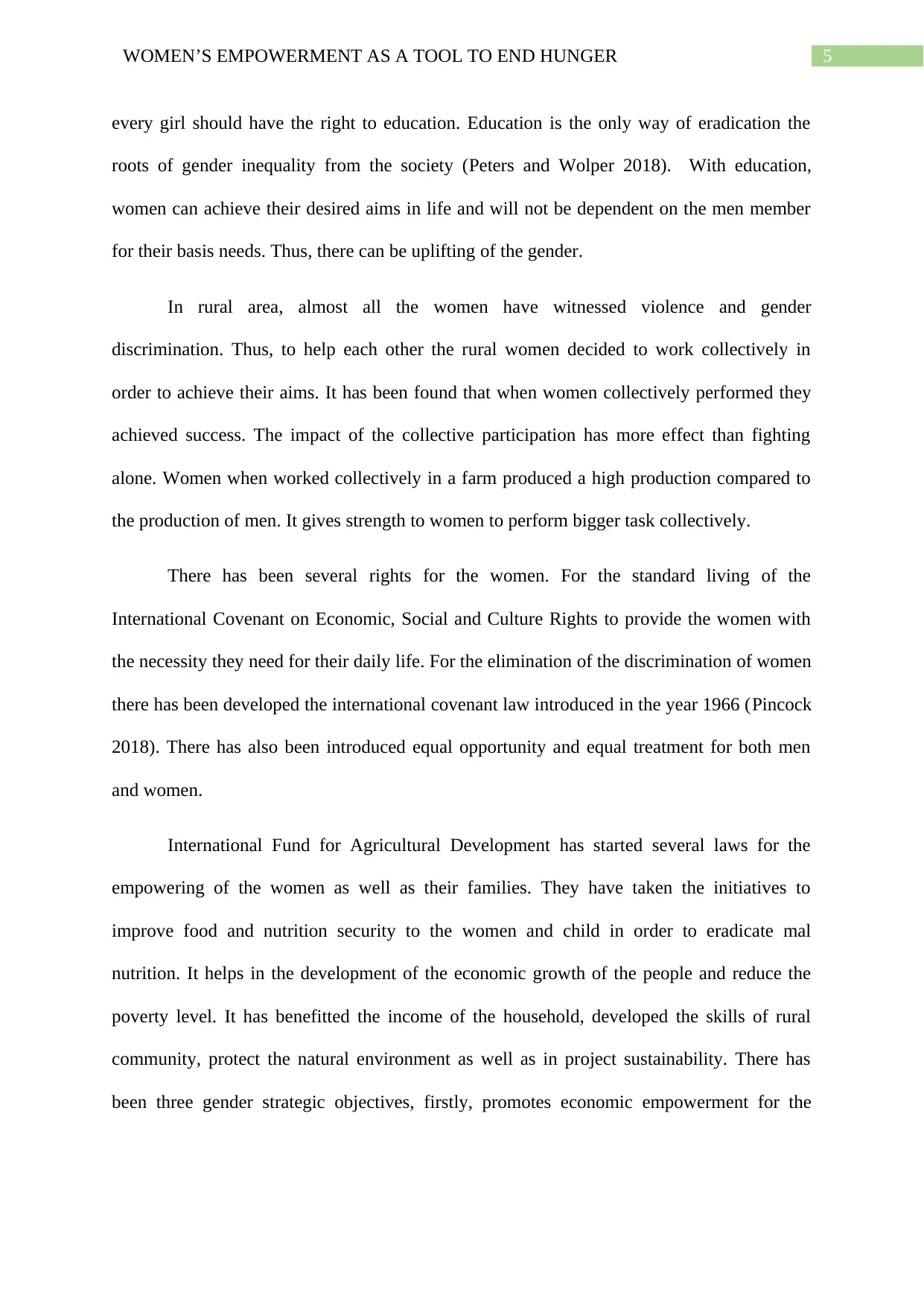
5WOMEN’S EMPOWERMENT AS A TOOL TO END HUNGER
every girl should have the right to education. Education is the only way of eradication the
roots of gender inequality from the society (Peters and Wolper 2018). With education,
women can achieve their desired aims in life and will not be dependent on the men member
for their basis needs. Thus, there can be uplifting of the gender.
In rural area, almost all the women have witnessed violence and gender
discrimination. Thus, to help each other the rural women decided to work collectively in
order to achieve their aims. It has been found that when women collectively performed they
achieved success. The impact of the collective participation has more effect than fighting
alone. Women when worked collectively in a farm produced a high production compared to
the production of men. It gives strength to women to perform bigger task collectively.
There has been several rights for the women. For the standard living of the
International Covenant on Economic, Social and Culture Rights to provide the women with
the necessity they need for their daily life. For the elimination of the discrimination of women
there has been developed the international covenant law introduced in the year 1966 (Pincock
2018). There has also been introduced equal opportunity and equal treatment for both men
and women.
International Fund for Agricultural Development has started several laws for the
empowering of the women as well as their families. They have taken the initiatives to
improve food and nutrition security to the women and child in order to eradicate mal
nutrition. It helps in the development of the economic growth of the people and reduce the
poverty level. It has benefitted the income of the household, developed the skills of rural
community, protect the natural environment as well as in project sustainability. There has
been three gender strategic objectives, firstly, promotes economic empowerment for the
every girl should have the right to education. Education is the only way of eradication the
roots of gender inequality from the society (Peters and Wolper 2018). With education,
women can achieve their desired aims in life and will not be dependent on the men member
for their basis needs. Thus, there can be uplifting of the gender.
In rural area, almost all the women have witnessed violence and gender
discrimination. Thus, to help each other the rural women decided to work collectively in
order to achieve their aims. It has been found that when women collectively performed they
achieved success. The impact of the collective participation has more effect than fighting
alone. Women when worked collectively in a farm produced a high production compared to
the production of men. It gives strength to women to perform bigger task collectively.
There has been several rights for the women. For the standard living of the
International Covenant on Economic, Social and Culture Rights to provide the women with
the necessity they need for their daily life. For the elimination of the discrimination of women
there has been developed the international covenant law introduced in the year 1966 (Pincock
2018). There has also been introduced equal opportunity and equal treatment for both men
and women.
International Fund for Agricultural Development has started several laws for the
empowering of the women as well as their families. They have taken the initiatives to
improve food and nutrition security to the women and child in order to eradicate mal
nutrition. It helps in the development of the economic growth of the people and reduce the
poverty level. It has benefitted the income of the household, developed the skills of rural
community, protect the natural environment as well as in project sustainability. There has
been three gender strategic objectives, firstly, promotes economic empowerment for the
⊘ This is a preview!⊘
Do you want full access?
Subscribe today to unlock all pages.

Trusted by 1+ million students worldwide
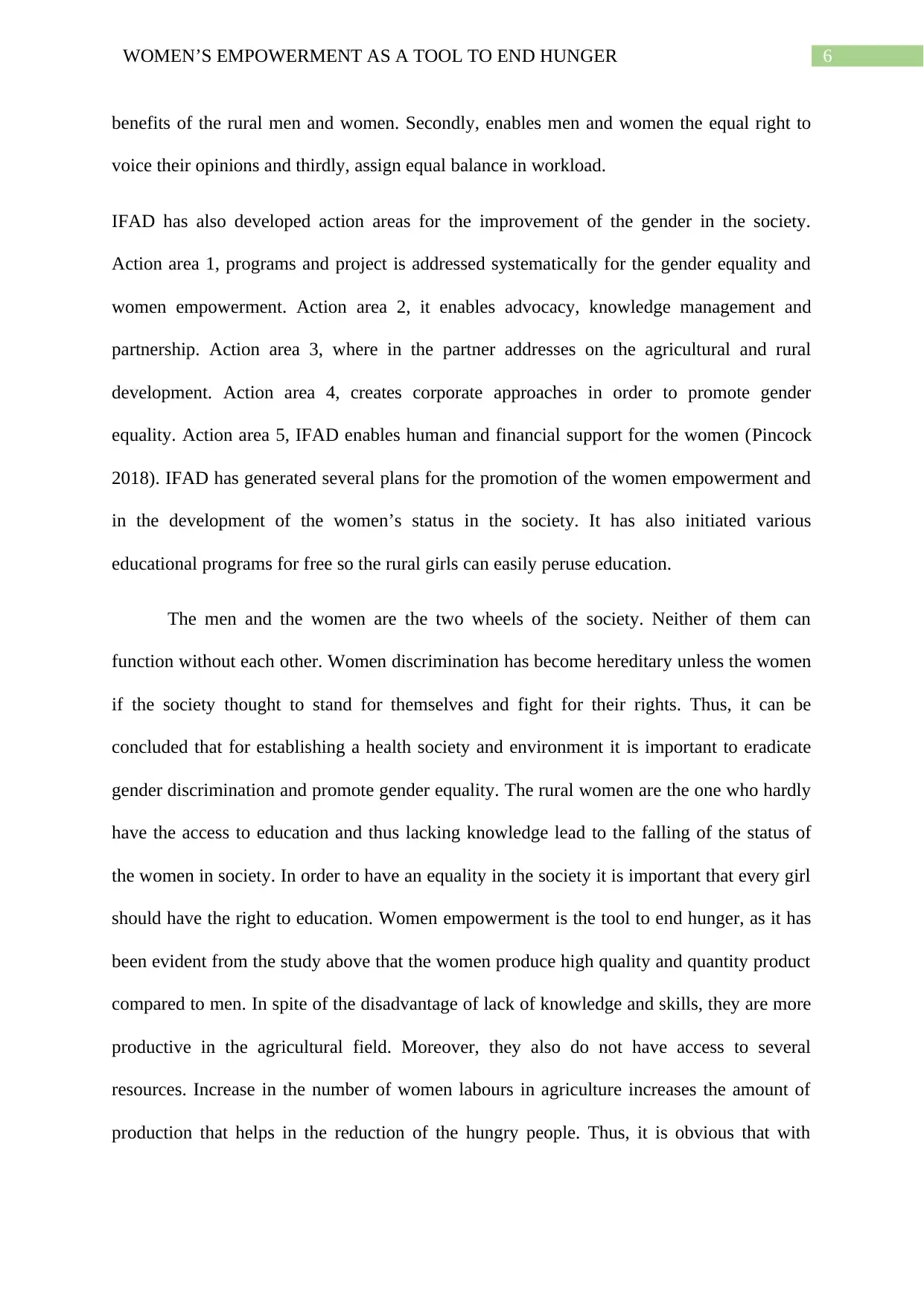
6WOMEN’S EMPOWERMENT AS A TOOL TO END HUNGER
benefits of the rural men and women. Secondly, enables men and women the equal right to
voice their opinions and thirdly, assign equal balance in workload.
IFAD has also developed action areas for the improvement of the gender in the society.
Action area 1, programs and project is addressed systematically for the gender equality and
women empowerment. Action area 2, it enables advocacy, knowledge management and
partnership. Action area 3, where in the partner addresses on the agricultural and rural
development. Action area 4, creates corporate approaches in order to promote gender
equality. Action area 5, IFAD enables human and financial support for the women (Pincock
2018). IFAD has generated several plans for the promotion of the women empowerment and
in the development of the women’s status in the society. It has also initiated various
educational programs for free so the rural girls can easily peruse education.
The men and the women are the two wheels of the society. Neither of them can
function without each other. Women discrimination has become hereditary unless the women
if the society thought to stand for themselves and fight for their rights. Thus, it can be
concluded that for establishing a health society and environment it is important to eradicate
gender discrimination and promote gender equality. The rural women are the one who hardly
have the access to education and thus lacking knowledge lead to the falling of the status of
the women in society. In order to have an equality in the society it is important that every girl
should have the right to education. Women empowerment is the tool to end hunger, as it has
been evident from the study above that the women produce high quality and quantity product
compared to men. In spite of the disadvantage of lack of knowledge and skills, they are more
productive in the agricultural field. Moreover, they also do not have access to several
resources. Increase in the number of women labours in agriculture increases the amount of
production that helps in the reduction of the hungry people. Thus, it is obvious that with
benefits of the rural men and women. Secondly, enables men and women the equal right to
voice their opinions and thirdly, assign equal balance in workload.
IFAD has also developed action areas for the improvement of the gender in the society.
Action area 1, programs and project is addressed systematically for the gender equality and
women empowerment. Action area 2, it enables advocacy, knowledge management and
partnership. Action area 3, where in the partner addresses on the agricultural and rural
development. Action area 4, creates corporate approaches in order to promote gender
equality. Action area 5, IFAD enables human and financial support for the women (Pincock
2018). IFAD has generated several plans for the promotion of the women empowerment and
in the development of the women’s status in the society. It has also initiated various
educational programs for free so the rural girls can easily peruse education.
The men and the women are the two wheels of the society. Neither of them can
function without each other. Women discrimination has become hereditary unless the women
if the society thought to stand for themselves and fight for their rights. Thus, it can be
concluded that for establishing a health society and environment it is important to eradicate
gender discrimination and promote gender equality. The rural women are the one who hardly
have the access to education and thus lacking knowledge lead to the falling of the status of
the women in society. In order to have an equality in the society it is important that every girl
should have the right to education. Women empowerment is the tool to end hunger, as it has
been evident from the study above that the women produce high quality and quantity product
compared to men. In spite of the disadvantage of lack of knowledge and skills, they are more
productive in the agricultural field. Moreover, they also do not have access to several
resources. Increase in the number of women labours in agriculture increases the amount of
production that helps in the reduction of the hungry people. Thus, it is obvious that with
Paraphrase This Document
Need a fresh take? Get an instant paraphrase of this document with our AI Paraphraser
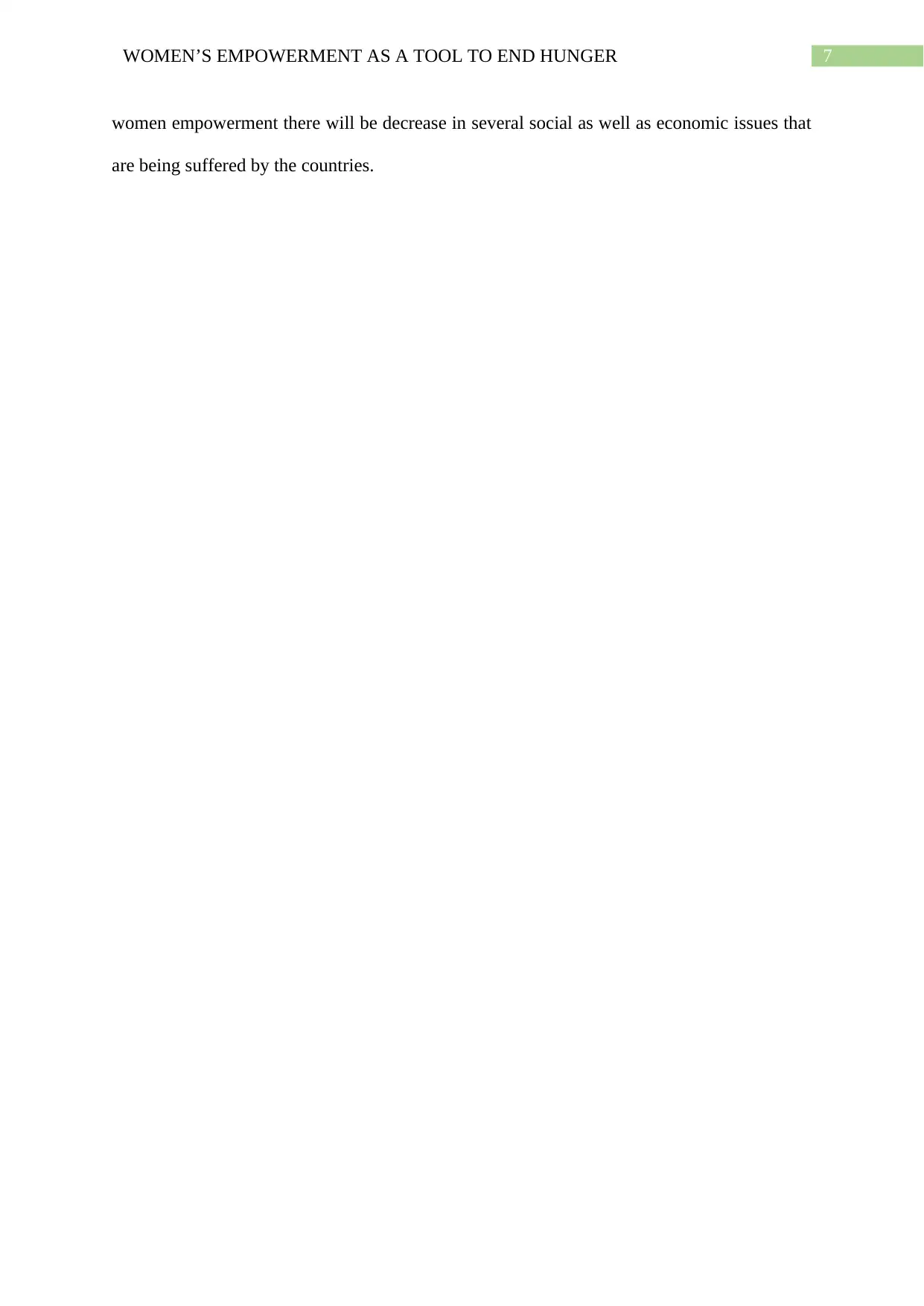
7WOMEN’S EMPOWERMENT AS A TOOL TO END HUNGER
women empowerment there will be decrease in several social as well as economic issues that
are being suffered by the countries.
women empowerment there will be decrease in several social as well as economic issues that
are being suffered by the countries.
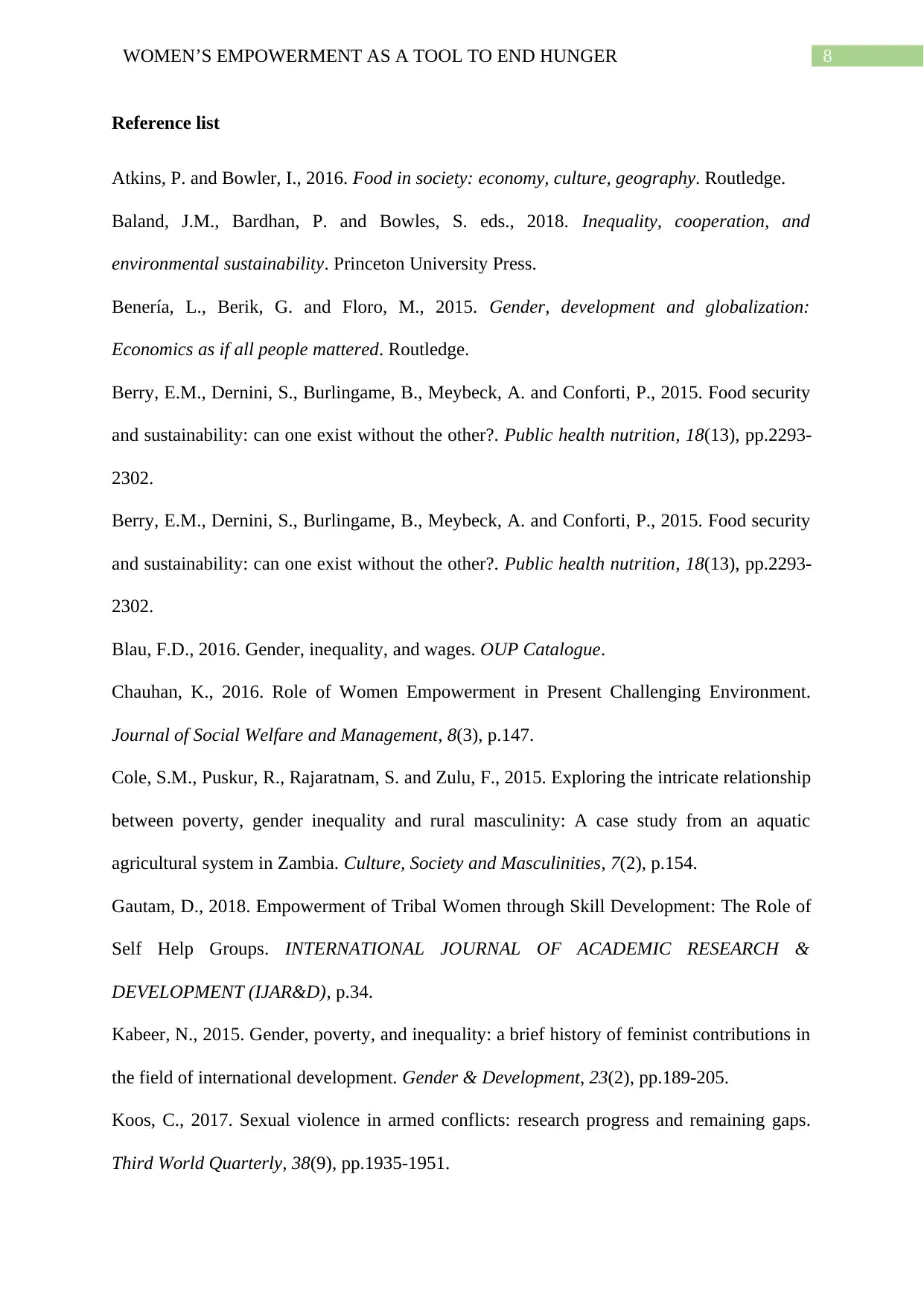
8WOMEN’S EMPOWERMENT AS A TOOL TO END HUNGER
Reference list
Atkins, P. and Bowler, I., 2016. Food in society: economy, culture, geography. Routledge.
Baland, J.M., Bardhan, P. and Bowles, S. eds., 2018. Inequality, cooperation, and
environmental sustainability. Princeton University Press.
Benería, L., Berik, G. and Floro, M., 2015. Gender, development and globalization:
Economics as if all people mattered. Routledge.
Berry, E.M., Dernini, S., Burlingame, B., Meybeck, A. and Conforti, P., 2015. Food security
and sustainability: can one exist without the other?. Public health nutrition, 18(13), pp.2293-
2302.
Berry, E.M., Dernini, S., Burlingame, B., Meybeck, A. and Conforti, P., 2015. Food security
and sustainability: can one exist without the other?. Public health nutrition, 18(13), pp.2293-
2302.
Blau, F.D., 2016. Gender, inequality, and wages. OUP Catalogue.
Chauhan, K., 2016. Role of Women Empowerment in Present Challenging Environment.
Journal of Social Welfare and Management, 8(3), p.147.
Cole, S.M., Puskur, R., Rajaratnam, S. and Zulu, F., 2015. Exploring the intricate relationship
between poverty, gender inequality and rural masculinity: A case study from an aquatic
agricultural system in Zambia. Culture, Society and Masculinities, 7(2), p.154.
Gautam, D., 2018. Empowerment of Tribal Women through Skill Development: The Role of
Self Help Groups. INTERNATIONAL JOURNAL OF ACADEMIC RESEARCH &
DEVELOPMENT (IJAR&D), p.34.
Kabeer, N., 2015. Gender, poverty, and inequality: a brief history of feminist contributions in
the field of international development. Gender & Development, 23(2), pp.189-205.
Koos, C., 2017. Sexual violence in armed conflicts: research progress and remaining gaps.
Third World Quarterly, 38(9), pp.1935-1951.
Reference list
Atkins, P. and Bowler, I., 2016. Food in society: economy, culture, geography. Routledge.
Baland, J.M., Bardhan, P. and Bowles, S. eds., 2018. Inequality, cooperation, and
environmental sustainability. Princeton University Press.
Benería, L., Berik, G. and Floro, M., 2015. Gender, development and globalization:
Economics as if all people mattered. Routledge.
Berry, E.M., Dernini, S., Burlingame, B., Meybeck, A. and Conforti, P., 2015. Food security
and sustainability: can one exist without the other?. Public health nutrition, 18(13), pp.2293-
2302.
Berry, E.M., Dernini, S., Burlingame, B., Meybeck, A. and Conforti, P., 2015. Food security
and sustainability: can one exist without the other?. Public health nutrition, 18(13), pp.2293-
2302.
Blau, F.D., 2016. Gender, inequality, and wages. OUP Catalogue.
Chauhan, K., 2016. Role of Women Empowerment in Present Challenging Environment.
Journal of Social Welfare and Management, 8(3), p.147.
Cole, S.M., Puskur, R., Rajaratnam, S. and Zulu, F., 2015. Exploring the intricate relationship
between poverty, gender inequality and rural masculinity: A case study from an aquatic
agricultural system in Zambia. Culture, Society and Masculinities, 7(2), p.154.
Gautam, D., 2018. Empowerment of Tribal Women through Skill Development: The Role of
Self Help Groups. INTERNATIONAL JOURNAL OF ACADEMIC RESEARCH &
DEVELOPMENT (IJAR&D), p.34.
Kabeer, N., 2015. Gender, poverty, and inequality: a brief history of feminist contributions in
the field of international development. Gender & Development, 23(2), pp.189-205.
Koos, C., 2017. Sexual violence in armed conflicts: research progress and remaining gaps.
Third World Quarterly, 38(9), pp.1935-1951.
⊘ This is a preview!⊘
Do you want full access?
Subscribe today to unlock all pages.

Trusted by 1+ million students worldwide
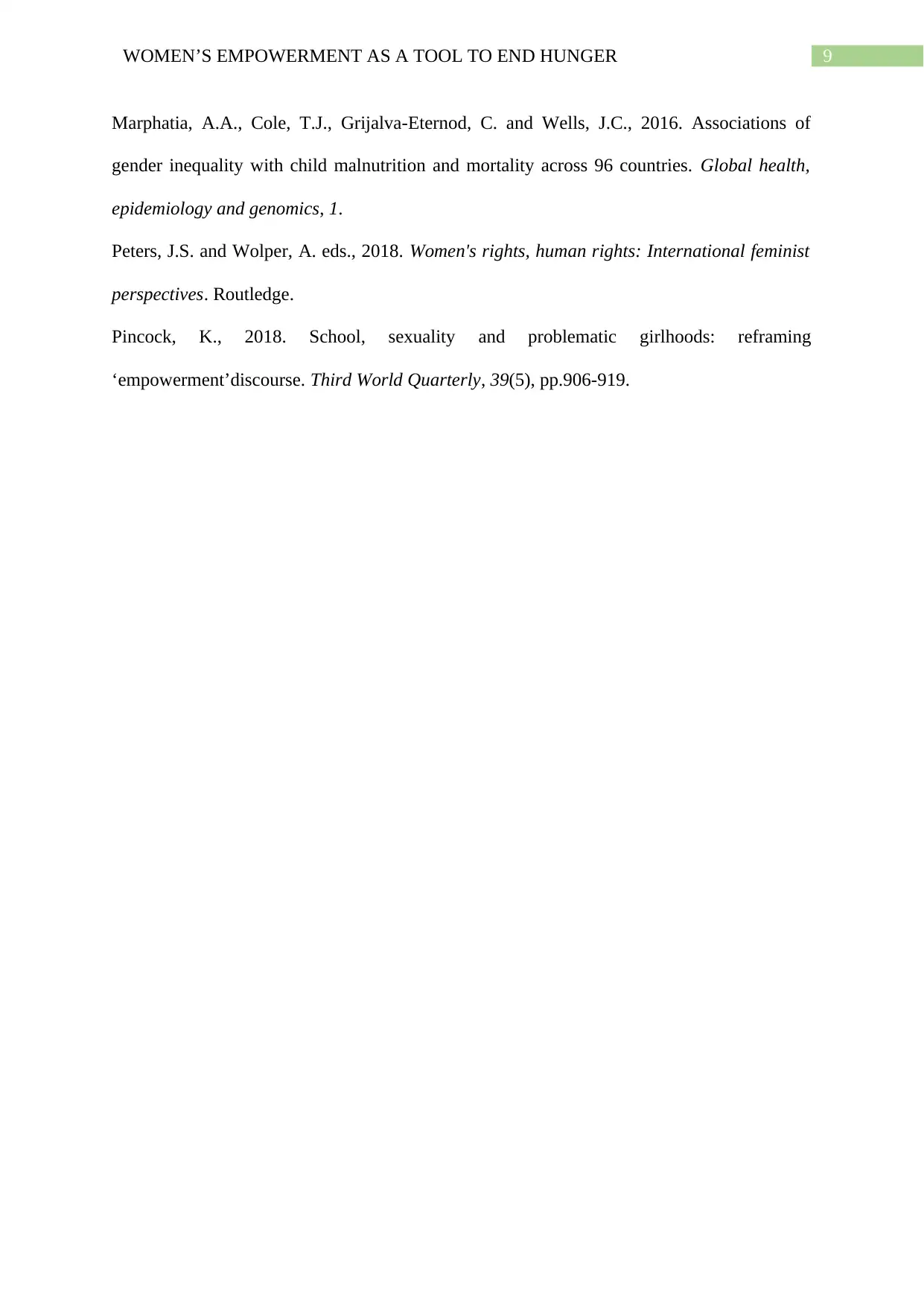
9WOMEN’S EMPOWERMENT AS A TOOL TO END HUNGER
Marphatia, A.A., Cole, T.J., Grijalva-Eternod, C. and Wells, J.C., 2016. Associations of
gender inequality with child malnutrition and mortality across 96 countries. Global health,
epidemiology and genomics, 1.
Peters, J.S. and Wolper, A. eds., 2018. Women's rights, human rights: International feminist
perspectives. Routledge.
Pincock, K., 2018. School, sexuality and problematic girlhoods: reframing
‘empowerment’discourse. Third World Quarterly, 39(5), pp.906-919.
Marphatia, A.A., Cole, T.J., Grijalva-Eternod, C. and Wells, J.C., 2016. Associations of
gender inequality with child malnutrition and mortality across 96 countries. Global health,
epidemiology and genomics, 1.
Peters, J.S. and Wolper, A. eds., 2018. Women's rights, human rights: International feminist
perspectives. Routledge.
Pincock, K., 2018. School, sexuality and problematic girlhoods: reframing
‘empowerment’discourse. Third World Quarterly, 39(5), pp.906-919.
1 out of 10
Related Documents
Your All-in-One AI-Powered Toolkit for Academic Success.
+13062052269
info@desklib.com
Available 24*7 on WhatsApp / Email
![[object Object]](/_next/static/media/star-bottom.7253800d.svg)
Unlock your academic potential
Copyright © 2020–2025 A2Z Services. All Rights Reserved. Developed and managed by ZUCOL.





